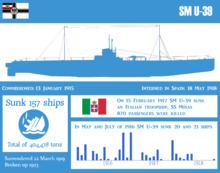Ordered 12 June 1912 Laid down 27 March 1913 Construction started 27 March 1913 Draft 3.56 m | Yard number 199 Commissioned 13 January 1915 Launched 26 September 1914 | |
 | ||
Fate Surrendered 22 March 1919, broken up 1923. Class and type German Type U 31 submarine Builder Friedrich Krupp Germaniawerft | ||
SM U-39 was a German Type U 31 U-boat which operated in the Mediterranean Sea during World War I. It ended up being the second most successful U-boat participating in the war, sinking 157 ships for a total of 404,478 tons.
Contents
Its longest-serving captain was Kptlt. Walther Forstmann, who was awarded the Pour le Mérite during command on U-39.
From January to mid-1917, Martin Niemöller served as U-39's coxswain. He is known as the author of the poem "First they came" which is inscribed at the New England Holocaust Museum. As an enemy of the Reich, he was imprisoned from 1938-1945 in Sachsenhausen and Dachau. In 1917 and 1918, Karl Dönitz served as watch officer on this boat. He later became Grand Admiral and Commander in Chief of the German Navy, and, for three weeks, the 4th President of Germany.
Design
German Type U 31 submarines were double-hulled ocean-going submarines similar to Type 23 and Type 27 subs in dimensions and differed only slightly in propulsion and speed. They were considered very good high sea boats with average manoeuvrability and good surface steering.
U-39 had an overall length of 64.70 m (212 ft 3 in), her pressure hull was 52.36 m (171 ft 9 in) long. The boat's beam was 6.32 m (20 ft 9 in) (o/a), while the pressure hull measured 4.05 m (13 ft 3 in). Type 31s had a draught of 3.56 m (11 ft 8 in) with a total height of 7.68–8.04 m (25 ft 2 in–26 ft 5 in). The boats displaced a total of 971 tonnes (956 long tons); 685 t (674 long tons) when surfaced and 878 t (864 long tons) when submerged.
U-39 was fitted with two Germania 6-cylinder two-stroke diesel engines with a total of 1,850 metric horsepower (1,361 kW; 1,825 bhp) for use on the surface and two Siemens-Schuckert double-acting electric motors with a total of 1,200 PS (883 kW; 1,184 shp) for underwater use. These engines powered two shafts each with a 1.60 m (5.2 ft) propeller, which gave the boat a top surface speed of 16.4 knots (30.4 km/h; 18.9 mph), and 9.7 knots (18.0 km/h; 11.2 mph) when submerged. Cruising range was 8,790 nautical miles (16,280 km; 10,120 mi) at 8 knots (15 km/h; 9.2 mph) on the surface, and 80 nmi (150 km; 92 mi) at 5 knots (9.3 km/h; 5.8 mph) under water. Diving depth was 50 m (164 ft 1 in).
The U-boat was armed with four 50 cm (20 in) torpedo tubes, two fitted in the bow and two in the stern, and carried 6 torpedoes. Additionally U-39 was equipped in 1915 with one 8.8 cm (3.5 in) deck gun, which was replaced with a 10.5 cm (4.1 in) in 1916/17. The boat's complement was 4 officers and 31 enlisted.
Fate
On 27 April 1918, U-39 sailed from Pola under command of Kapitänleutnant Heinrich Metzger, for operations in the Western Mediterranean. On 17 May, together with SM UB-50, U-39 operated against a convoy North of Oran, from which it sank the British steamer Sculptor (4,874 tons) in a submerged attack.
At 13:50 on 18 May, when in a position 36°36′N 00°02′W, U-39 was attacked by two French seaplanes. It crash-dived, but when reaching a depth of 12 meters two bombs exploded very close; the after torpedo room flooded, the diving planes were destroyed, and the boat began sinking by the stern. Kptlt. Metzger ordered the tanks blown and U-39 surfaced, but the heavy damage suffered prevented diving again. Metzger was forced to lay a course for the nearest Spanish harbour, Cartagena.
At about 17:00, U-39 was attacked again by two seaplanes; it fought back with gun and machine-guns, and the enemy bombs caused no damage, but during the action two crewmen (sailor Schulz and stoker Hausottl) fell overboard and were lost.
In the evening U-39 reached Cartagena and was interned for the remainder of the war.
It was surrendered to France on 22 March 1919 and was broken up at Toulon in 1923.
